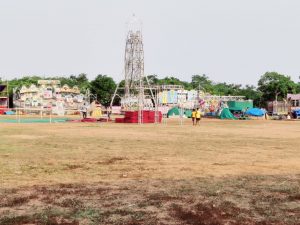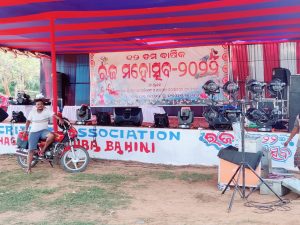Raja Fervour Back In Bhubaneswar’s Patrapada With Over 100 Swings, Meena Bazaar & Fun Rides

Bhubaneswar: After two years of hiatus owing to COVID pandemic, Odisha is gearing up to celebrate Raja, which is an amalgamation of rich tradition along with fun, frolic, and mouthwatering cuisines. This three-day festival also celebrates womanhood by likening the menstrual cycle to Mother Earth’s rejuvenation and acknowledging the need for her to rest on these days.
And at Patrapada this year, the festivity will last for four days, starting Tuesday (June 14). “We lost several trees during cyclone Fani. The trees are now being joined to erect over 107 bamboo swings,” said Rabindra Nath Sahoo, a senior member of the organising team.
It all began in 1919-92 with a plantation drive in which Simulia saplings were sown on around 14 acres. “As the trees became big, we started putting up swings,” he said.
The Raja festival is being celebrated here since 2011. “Initially, we had installed only 30 swings. In 2017, there were 121 swings and in 2019, the number crossed 150. The COVID restrictions put a halt to the event and we had put up a swing with Radha-Krishan as a ceremonial gesture,” Sahoo said.
The excitement is back and so are the festivities. Besides the swings, there will be Mehendi, Puchi, Jhoti, Muruja Hula Huli, conch and balloon blowing, chess, cards, and pasha competitions. A Meena Bazaar is also being erected at the spot with Ram Dholi and other fun rides.

There will also be a state-level kabaddi competition on the first two days, he informed, adding that the evening will be colourful with various cultural programmes.
The event is being organised by Maharaja Cricket Association and Patrapada Bhagwanpur Yuvabahani. “The main aim of this arrangement is to celebrate womanhood and brotherhood in one place. Forgetting all societal differences, all will come together to celebrate the three-day-long festival,” he said.
People from Patrapada, Sijua, Dumduma, Khurda, Bhubaneswar and Cuttack also come here to celebrate the occasion, he added.

The very first day of this three-day-long festival is termed Pahili Raja which is also considered to be the last day of the month Jestha (summers). The second day , Raja Sankaranti, is the first day of the month Asadha(monsoons). The concluding day is named in the local dialect as Bhuin Dahana popularly known as Sesa Raja (last day). However, the festival in some parts of the regions actually ranges for a period of four days with Basumata Puja or Basumata Gadhua (bathing and praying of mother earth) on the fourth day.

Comments are closed.